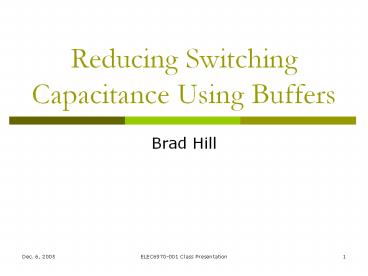Reducing Switching Capacitance Using Buffers - PowerPoint PPT Presentation
Title:
Reducing Switching Capacitance Using Buffers
Description:
... driving the buffer now sees a single fanout instead of a large fanout ... Extra Large Drive Transistors. Reduce Charging Resistance. Increase Drive Capacity ... – PowerPoint PPT presentation
Number of Views:38
Avg rating:3.0/5.0
Title: Reducing Switching Capacitance Using Buffers
1
Reducing Switching Capacitance Using Buffers
- Brad Hill
2
Objective
- Reduce the Power of a Multiplier Circuit
- Do this with out Increasing the Delay of the
Critical Path
3
Problem of Fanout
- Fanout Increases the Capacitive Load on the
Driving Transistor - RC time constant increases due to increased load
capacitance - Delay of the circuit increases
4
Reasoning Behind Buffers
- Single Fanout
- The transistor driving the buffer now sees a
single fanout instead of a large fanout - There is a steady increase in transistor size
between stages - Extra Large Drive Transistors
- Reduce Charging Resistance
- Increase Drive Capacity
- Lowers the RC time constant and speeds up the
switching to reduce delay - This does not directly reduce power but can be
used to our advantage
5
2x Buffer
6
Multiplier
- Simulated cells and circuits with multiple cells
compared results - Found the best configuration of the buffers in
the circuits to reduce the delay
7
Critical Path
8
Cell with Buffers
- The fanout of both Sum_in and Carry_in in the
Cell is 6 - These two signals benefit the most from buffers
9
Delay of a Cell without Buffers (1.8V)
10
Cell with Buffers (1.8V)
11
Cell Delay (1.75V)
12
Cell With Buffer Delay (1.75V)
13
Comparison
Dynamic(W) Static(W) Delay(S) Supply Voltage
Single Cell 33.86u 171.14p 14.942p 1.8V
Cell with buffers 35.08u 243.98p -129.56p 1.8V
No Buffers 31.44u 162.10p 16.129p 1.75V
Buffers 32.34u 230.87p -120.778p 1.75V
Difference -1.52u 59.73p -135.72 -0.05V
14
Two Cells with Buffers
- The two cells represent two cells in the middle
of the multiplier - A, B, B1, Sum_in, Carry_in, and Sum_in1 are
driven for the simulation
15
Cells 1.8V
16
Cells no Buffers 1.75V
17
Cells with Buffers 1.75V
18
Two Cell Simulation Comparison
Dynamic(W) Static(W) Delay(S) Supply Voltage
No Buffers 467.126u 342.282p 12.081p 1.8V
Buffers 488.136u 487.96p -7.85p 1.8V
No Buffers 418.677u 324.2060p 13.510p 1.75V
Buffers 438.90u 461.75p 5.095p 1.75V
Difference -28.226u 119.552p -6.986p -0.05V
19
Area of Cell
Gate Area
AO32 288
XOR 310
XNOR 282
NAND 88
Total 968
20
Increase in Area
- Area of a 2x Buffer
- 84
- Area of Buffered Cell
- 1136
- Percent Increase
- 17.36
21
Conclusions
- Strategically placed buffers can greatly decrease
the delay of a circuit - This reduction in delay can be used to offset the
increase in delay due to some power reduction
schemes































